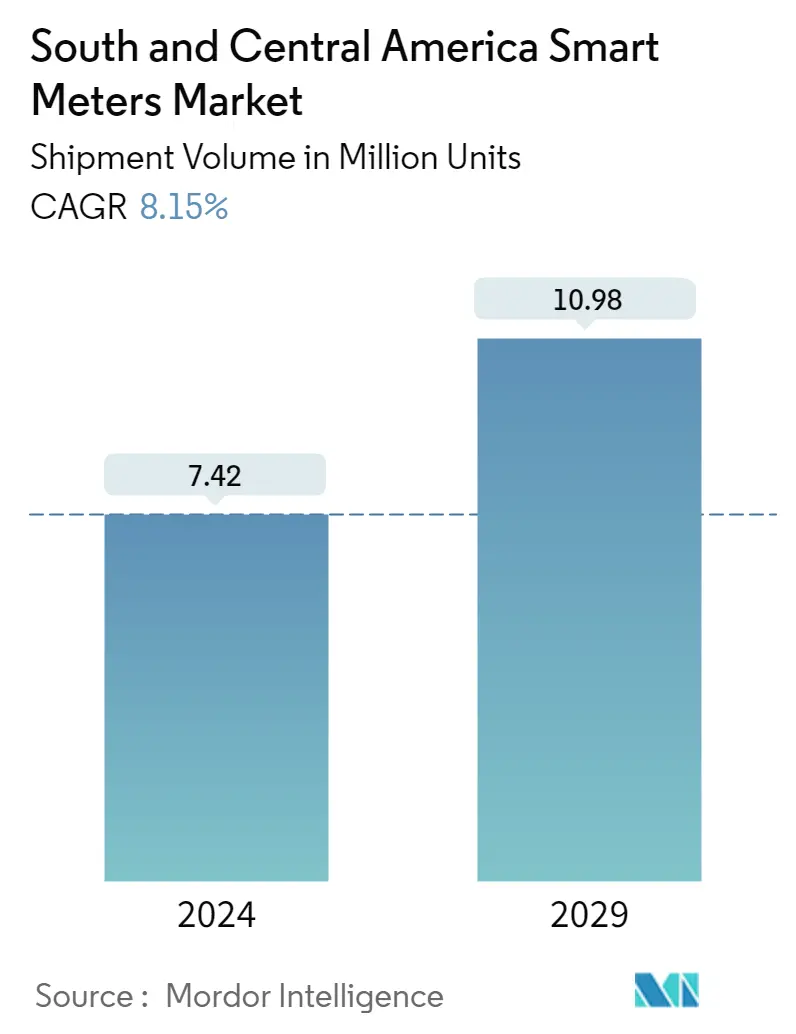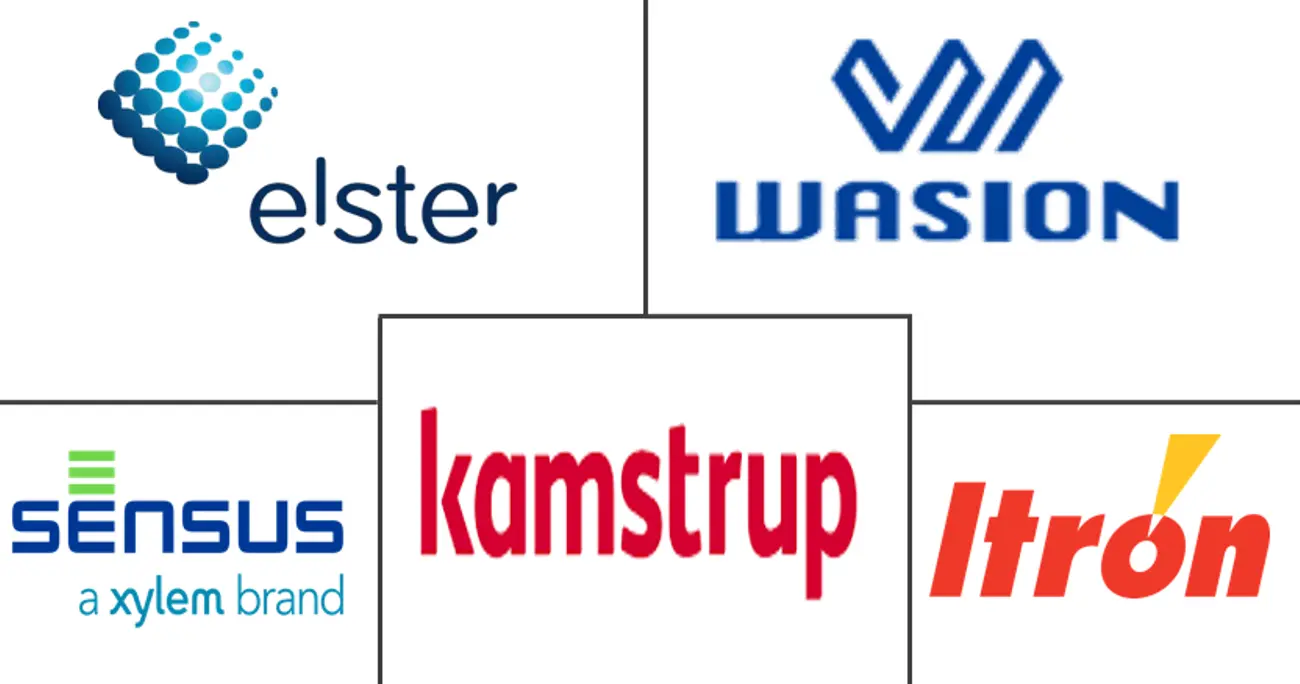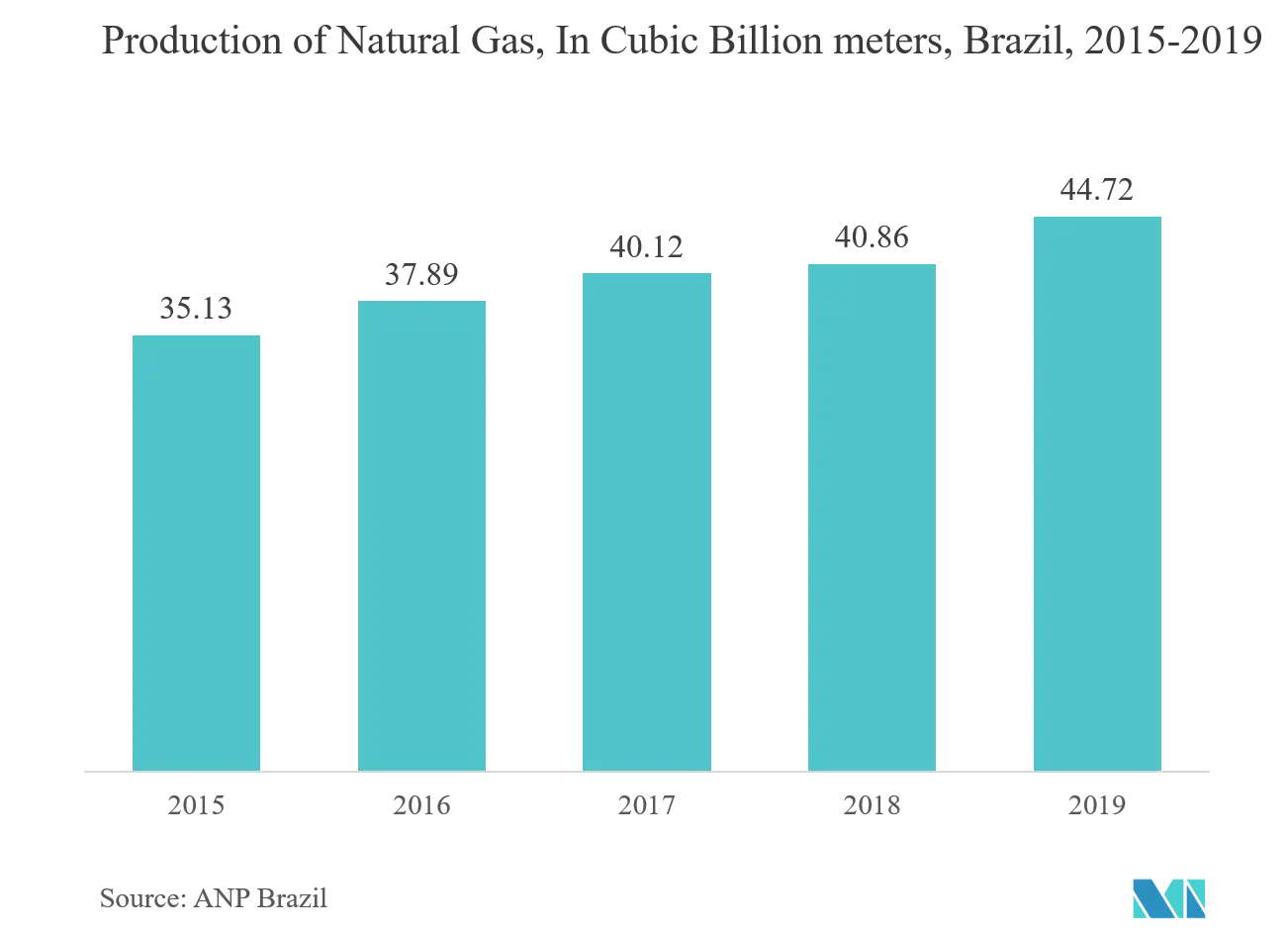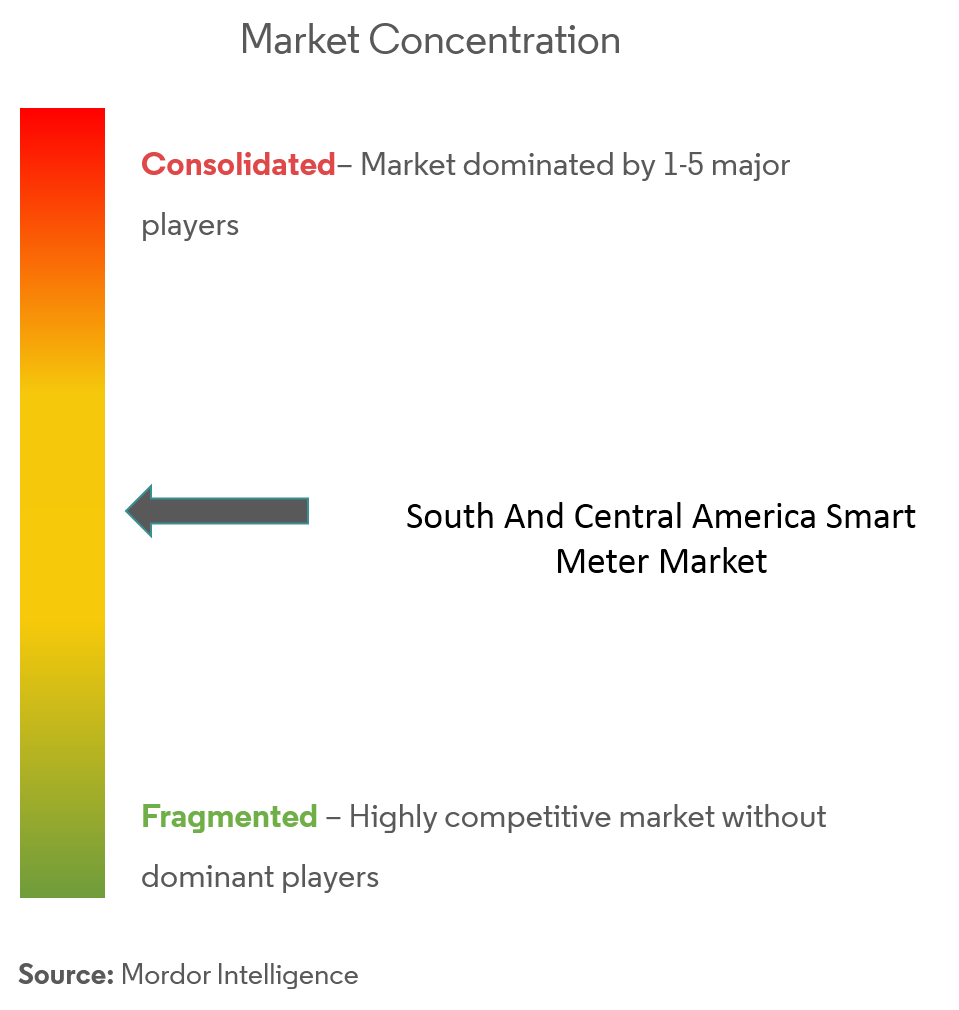South and Central America Smart Meters Market Size

| Study Period | 2019 - 2029 |
| Base Year For Estimation | 2023 |
| Market Volume (2024) | 7.42 Million units |
| Market Volume (2029) | 10.98 Million units |
| CAGR (2024 - 2029) | 8.15 % |
| Market Concentration | Medium |
Major Players
*Disclaimer: Major Players sorted in no particular order |
South and Central America Smart Meters Market Analysis
The South and Central America Smart Meters Market size in terms of shipment volume is expected to grow from 7.42 Million units in 2024 to 10.98 Million units by 2029, at a CAGR of 8.15% during the forecast period (2024-2029).
The recent COVID-19 outbreak and nationwide lockdown impacted the overall rollout of smart meters in South and Central America. The global COVID-19 pandemic resulted in lockdowns in various parts of the region, which halted several operations across the industries. As a result, the shipments and installations of smart meters also witnessed a downfall.
- The market is primarily driven by governmental roll-outs for large-scale incorporations, in the absence of which the primary drivers are theft prevention and reduction of other non-technical losses, along with functionality improvements, such as the ability to control utilities remotely and time-based tariffs. However, countries lacking supporting legislation are witnessing slow growth in the market, with the patchy implementation of the technology. This also inhibits these systems from performing at their optimal level.
- Mexico and Brazil lead the Latin American region when it comes to the adoption of smart meters. In Brazil, utilities, such as AES Eletropaulo, Eletrobras, Celpa, Light, and others, have experimented with smart meters from pilot-scale projects to multimillion-meter deployments. For instance, in Mexico, state-run utility CFE is in the process of converting 30.2 million customers to smart meters by 2025. New markets, such as Columbia, Peru, and Chile, are also expected to witness a demand for smart meters over the forecast period.
- The market for smart water meters, however, is in a nascent stage in the region, lacking any large-scale deployments. However, the water scarcity in some nations has led to the initiation of trial phases. According to the estimates by the Development Bank of Latin America (CAF), the water infrastructure demand in Latin America requires an investment of about 0.3% of the GDP until 2030.
- The region is characterized by enormous variations in the economic, social and political structures for private investments. This level of privatization is expected to invite foreign investments to adopt smart technology solutions in the water distribution sector in the region. For instance, in March 2020, Esval and Aguas del Valle chose TaKaDu to improve its water network management and protect the water resources of Chilean regions IV and V. The solution is expected to be implemented in 100% of the group's networks, corresponding to about 7,000 km. Currently, nearly 13,000 sensors have been deployed.
- This increase in population has caused an increase in the consumption of water. Currently, agriculture accounts for 77% of water consumption; domestic uses account for 13% and industry for 10%. With considerable economic activities and an increasing population, the Mexican residents of northwest, semi-arid, arid north, and central regions use an average of 75 gallons of water a day, which is more than that of a US resident.
- Further, to encourage renewable energy investment in Mexico, the administration addressed infrastructure bottlenecks. It realized that as power demand grows, the aging transmission lines need to be upgraded to reduce losses. Further, the transmission and distribution losses have been attributed to infrastructure, illegal access, poor metering, and incorrect billing, to name a few.
- In line with the country's Uruguay Digital 2020 Agenda, UTE plans installation project of smart meters in households and companies in the country. As part of the World Day of the Information Society, in May 2019, the company announced its' commitment to reach 50% of its 1,500,000 customers by the end of 2020.
South and Central America Smart Meters Market Trends
This section covers the major market trends shaping the South & Central America Smart Meters Market according to our research experts:
Need for Improvement in Utility Efficiency to Drive the Market
- Many developing nations within the region are facing problems with energy efficiency, due to the increasing economic activities, which has substantially increased energy consumption rates. These countries also account for the majority share of carbon emissions. Thus, governments across the region are focusing on decreasing their emissions by focusing on renewable energy sources and increasing the efficiency of the existing network by deploying smart metering systems and other technologies.
- Owing to enhancing their energy efficiency, major countries in the region have already formed regulations, and other countries are following suit. Such developments in the region are forcing businesses and homes to adopt energy efficiency solutions.
- Further, smart meters adoption is expected to grow significantly, fueled by the UN climate target and related energy efficiency measures. Smart gas meters help reduce fuel consumption of gas heating systems, indirectly, affecting the growth of a fully automated grid. Such trends are expected to boost the adoption of smart meters worldwide.
- Deployment of smart grids and smart metering systems provides solutions to curb energy wastage in the industry. Implementation of smart metering systems enables energy suppliers to continuously monitor electricity usage by employing smart meter systems at multiple points in the grid.
.webp)
Brazil to Hold a Major Share for Gas Meter Market
- The Brazilian government announced a funding of around USD 200 million for the development of smart grids. It also announced plans to deploy smart meters in the entire country by 2021. The aforementioned factors, coupled with Brazil's strong focus on renewable energy generation, are expected to act as driving factors for the Brazilian smart gas meter market.
- With the growing need for natural gas and the construction of pipelines in Brazil, the utility sector is now leveraging the benefits of the Internet of Things, in order to bring about smart gas meters in various businesses. Smart gas metering systems have become the most desirable option, and they are now providing billing accuracy, real-time data monitoring, and improved customer service.
- According to ANP Brazil, the natural gas production in Brazil reached nearly 41 billion cubic meters in 2018, representing an increase of more than 93% as compared to that of 2009, when production in the country totalled 21 billion cubic meters. As per the statistics provided by BP and EIA, Brazil accounted for about 24.1% of the global biofuel production. Hence, Brazil is among the top three countries in terms of biofuel production.
- The smart gas meter market acts as a lucrative vertical for the overall smart metering industry in Brazil, and it was recently bestowed with unprecedented gains driven by robust product deployment across the biofuel and natural gas sectors in the region. Besides, the smart gas metering concept is now present in six Brazilian states, including São Paulo, Rio de Janeiro, Paraná, and the Amazonas, involving local providers and consequently boosting the market growth.
- Enel accomplished a significant smart city track record in its areas of presence. Some smart city projects across the Latin American region have strived to make broadband accessible to the public, such as Brazil's Rede Cidade Digital, which comprises 300 municipalities.

South and Central America Smart Meters Industry Overview
The South and Central American smart meter market is moderately competitive and consists of several major players. In terms of market share, few of the major players currently dominate the market. These major players with prominent shares in the market are focusing on expanding their customer base across foreign countries. These companies are leveraging strategic collaborative initiatives to increase their market shares and profitability. The companies operating in the market are also acquiring start-ups working on smart meter technologies to strengthen their product capabilities.
- Jan 2020 - Landis+Gyr launched an Omni-carrier cellular meter and services solution in order to simplify the installation and operation of cellular communications for utility IoT applications. With a single meter model supporting a variety of available cellular carriers, the meter can automatically provision the optimal carrier network on installation and provides increased resilience with automatic failover.
South and Central America Smart Meters Market Leaders
-
WASION GROUP HOLDINGS
-
Elster Group GmbH (Honeywell International Inc.)
-
KAMSTRUP AS
-
ITRON INC.
-
Sensus, a Xylem brand
*Disclaimer: Major Players sorted in no particular order

South and Central America Smart Meters Market News
- June 2020- Itron Inc. announced partnership with Accell, as Itron's regional partner and lead distributor for the Latin America region. As part of the agreement, Accell will manufacture devices sold in Latin America and provide services and support for those products. By partnering with Accell in Latin America, Itron furthers its strategy to enhance flexibility to capitalize on other opportunities. Accell is better situated to serve customers, partners and deliver new levels of success in the region.
- January 2020- Kamstrup completed the acquisition of a smaller Danish software company Blue Control. The acquisition and investment in Blue Control is part of its long-term strategy to increase its growth within digital solutions for the water industry. At the same time it is about supporting a company in developing their product and business.
South and Central America Smart Meters Market Report - Table of Contents
1. INTRODUCTION
1.1 Study Assumptions and Market Definition
1.2 Scope of the Study
2. RESEARCH METHODOLOGY
3. EXECUTIVE SUMMARY
4. MARKET DYNAMICS
4.1 Market Overview
4.2 Industry Attractiveness - Porter's Five Forces Analysis
4.2.1 Bargaining Power of Suppliers
4.2.2 Bargaining Power of Consumers
4.2.3 Threat of New Entrants
4.2.4 Intensity of Competitive Rivalry
4.2.5 Threat of Substitutes
4.3 Impact of COVID-19 on the Market
4.4 Industry Value Chain Analysis
4.5 Market Drivers
4.5.1 Increased Investments in Smart Grid Projects
4.5.2 Need for Improvement in Utility Usage and Efficiency
4.5.3 Supportive Government Regulations
4.5.4 Growth in Smart City Deployment
4.5.5 Demand for Sustainable Utility Supply to All End Users
4.6 Market Restraints
4.6.1 High Costs and Security Concerns
4.6.2 Integration Difficulties with Smart Meters
4.6.3 Lack of Capital Investment for Infrastructure Installation and Lack of ROI
4.6.4 Utility Supplier Switching Costs
5. MARKET SEGMENTATION
5.1 Smart Gas Meter
5.1.1 Brazil
5.1.2 Mexico
5.1.3 Argentina
5.1.4 Chile
5.1.5 Rest of South and Central America
5.2 Smart Water Meter
5.2.1 Brazil
5.2.2 Mexico
5.2.3 Argentina
5.2.4 Chile
5.2.5 Rest of South and Central America
5.3 Smart Electricity Meter
5.3.1 Brazil
5.3.2 Mexico
5.3.3 Argentina
5.3.4 Chile
5.3.5 Rest of South and Central America
6. COMPETITIVE LANDSCAPE
6.1 Company Profiles*
6.1.1 Wasion Group Holdings
6.1.2 Elster Group GmbH (Honeywell)
6.1.3 Kamstrup AS
6.1.4 Itron Inc.
6.1.5 Sensus USA Inc.
6.1.6 Diehl Stiftung & Co. KG
6.1.7 Zenner International GmbH & Co. KG
6.1.8 Echelon Corporation
6.1.9 Arad Group
6.1.10 Sagemcom USA Inc.
6.1.11 Landis+Gyr Group AG
6.1.12 General Electric Company
7. INVESTMENT ANALYSIS
8. MARKET OPPORTUNITIES AND FUTURE TRENDS
South and Central America Smart Meters Industry Segmentation
A smart meter is an electronic machine that reads information such as the consumption of electric energy, current, voltage levels, and power factor. Smart meters transmit the information to the customer for greater accuracy of consumption behavior, and electricity suppliers for system monitoring and customer billing.
The different kinds of smart meters considered in the scope of this report are - smart gas meter, smart water meter, and smart electricity meter. The study also includes a categorization of the study of the applications of these meters for commercial, industrial, and residential purposes.
Smart gas and smart energy meters are deployed to measure the gas flow and electricity consumption, using wireless communication, thereby allowing infrastructural maintenance, remote location monitoring, and automatic billing.
A smart water meter uses wireless communication technologies to measure water flow in real-time, allowing remote location monitoring and infrastructural maintenance through leak detection.
| Smart Gas Meter | |
| Brazil | |
| Mexico | |
| Argentina | |
| Chile | |
| Rest of South and Central America |
| Smart Water Meter | |
| Brazil | |
| Mexico | |
| Argentina | |
| Chile | |
| Rest of South and Central America |
| Smart Electricity Meter | |
| Brazil | |
| Mexico | |
| Argentina | |
| Chile | |
| Rest of South and Central America |
South and Central America Smart Meters Market Research FAQs
How big is the South and Central America Smart Meters Market?
The South and Central America Smart Meters Market size is expected to reach 7.42 million units in 2024 and grow at a CAGR of 8.15% to reach 10.98 million units by 2029.
What is the current South and Central America Smart Meters Market size?
In 2024, the South and Central America Smart Meters Market size is expected to reach 7.42 million units.
Who are the key players in South and Central America Smart Meters Market?
WASION GROUP HOLDINGS , Elster Group GmbH (Honeywell International Inc.) , KAMSTRUP AS , ITRON INC. and Sensus, a Xylem brand are the major companies operating in the South and Central America Smart Meters Market.
What years does this South and Central America Smart Meters Market cover, and what was the market size in 2023?
In 2023, the South and Central America Smart Meters Market size was estimated at 6.86 million units. The report covers the South and Central America Smart Meters Market historical market size for years: 2019, 2020, 2021, 2022 and 2023. The report also forecasts the South and Central America Smart Meters Market size for years: 2024, 2025, 2026, 2027, 2028 and 2029.
South and Central America Smart Meters Industry Report
Statistics for the 2024 South and Central America Smart Meters market share, size and revenue growth rate, created by Mordor Intelligence™ Industry Reports. South and Central America Smart Meters analysis includes a market forecast outlook to 2029 and historical overview. Get a sample of this industry analysis as a free report PDF download.



